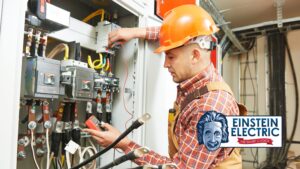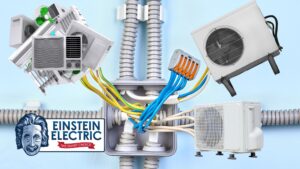Dangerous electrical wiring is a serious issue that can pose a significant threat to both people and property. Electrical wiring can become dangerous for a variety of reasons, including wear and tear, damage, and outdated equipment. In this article, we’ll take a closer look at what constitutes dangerous electrical wiring and how to identify and prevent it.
- Old or Outdated Wiring
One of the most common causes of dangerous electrical wiring is outdated or old wiring. Many older homes and buildings have wiring that was installed decades ago and is no longer up to code. Older wiring may not be able to handle the electrical load required by modern appliances and electronics, leading to overloaded circuits and potential fires.
If you live in an older home or building, it’s important to have your wiring inspected by a licensed electrician to ensure that it is up to code. Upgrading your wiring to meet modern standards can help prevent dangerous electrical problems and increase energy efficiency.
. Outdated or old wiring is a significant concern in many older homes and buildings. Here are some additional details about the issues associated with outdated wiring:
- Insufficient capacity: Older wiring systems were designed to accommodate lower electrical demands than what we have today. As a result, they may not be equipped to handle the increased electrical load created by modern appliances, electronics, and other high-energy devices. This can lead to overloaded circuits, which can overheat and potentially cause electrical fires.
- Material deterioration: Over time, the insulation and other components of wiring can deteriorate. The insulation around wires may become brittle, cracked, or frayed, exposing live wires. This increases the risk of electrical shock and fire hazards. Additionally, older wiring systems might include materials such as knob-and-tube or cloth-covered wiring, which are less durable and more prone to damage.
- Lack of grounding: Many older wiring systems lack a proper grounding system. Grounding is crucial for safety, as it provides a path for electrical faults or surges to dissipate harmlessly into the ground. Without proper grounding, there is an increased risk of electric shock and equipment damage during electrical faults.
- Inadequate circuit protection: Older wiring systems may not have the appropriate circuit protection measures, such as circuit breakers or ground fault circuit interrupters (GFCIs). Circuit breakers and GFCIs are essential for detecting faults, preventing overloads, and minimizing electrical hazards. Without these safety features, the risk of electrical accidents and fires is higher.
- Code compliance: Building codes and electrical standards have evolved over time to enhance safety. Wiring systems in older homes may not meet the current electrical codes and standards. These codes are in place to ensure proper installation, adequate capacity, and safety measures. Outdated wiring may not comply with these regulations, making it more susceptible to hazards.
If you suspect that your home or building has outdated or old wiring, it is essential to have a qualified electrician inspect the system. They can assess the condition of the wiring, identify any potential hazards, and recommend necessary upgrades or repairs to ensure the electrical system is safe and up to code.
- Overloaded Circuits
Another common cause of dangerous electrical wiring is overloaded circuits. Overloaded circuits occur when too many appliances or devices are plugged into a single outlet or circuit, causing the wiring to heat up and potentially start a fire.
Overloaded circuits are a significant concern when it comes to electrical safety. Here are some key points regarding overloaded circuits:
- Exceeding amperage capacity: Every electrical circuit is designed to handle a specific amount of electrical current, measured in amperes (amps). Plugging in too many devices or appliances that collectively draw more current than the circuit can handle leads to an overload. This causes the wiring to heat up, potentially damaging the insulation and increasing the risk of an electrical fire.
- Inadequate circuit design: Poor circuit design, such as having too few outlets or circuits for the electrical demands of a particular area, can contribute to overloading. In older buildings, there may be a limited number of outlets available, leading to the use of power strips or extension cords, which can easily become overloaded if not used properly.
- High-power appliances: Certain appliances, such as air conditioners, electric heaters, and large kitchen appliances, require a significant amount of electrical power to operate. Plugging these appliances into circuits that are not specifically designed to handle their power requirements can overload the circuit.
- Extension cords and power strips: While extension cords and power strips can provide additional outlets, they should not be used as a permanent solution for lack of outlets. Overloading these devices by connecting too many appliances or devices to them can lead to overheating and potential hazards.
- Lack of circuit protection: Circuit breakers are designed to detect overloads and trip, cutting off the power to the circuit. However, if the circuit breaker is faulty or not properly sized for the circuit, it may not provide adequate protection against overloads.
To prevent overloaded circuits and mitigate the associated risks, consider the following safety measures:
- Use multiple circuits: Distribute the electrical load among multiple circuits to avoid overloading a single circuit. Ensure that the total load on each circuit remains within its amperage capacity.
- Avoid daisy-chaining power strips: Plugging multiple power strips into one another, known as daisy-chaining, can overload the circuit. Instead, use power strips sparingly and directly connect appliances to outlets whenever possible.
- Use heavy-duty extension cords: If you need to use an extension cord, choose one that is appropriately rated for the power requirements of the connected appliances. Avoid using extension cords as a permanent solution.
- Upgrade electrical circuits: If you frequently experience overloaded circuits or have older electrical systems, consider consulting a qualified electrician to assess your electrical needs and potentially upgrade your wiring to handle the increased power demand.
By practicing electrical load management and ensuring proper circuit design, you can reduce the risk of overloaded circuits and help maintain a safe electrical system in your home or building.
- Damaged Wiring
Damaged wiring is another common cause of dangerous electrical problems. Wiring can become damaged over time due to wear and tear, exposure to moisture, or rodent infestations. Damaged wiring can create sparks, shorts, and other hazards that can lead to fires and electrocution.
To prevent damaged wiring, it’s important to have your wiring inspected regularly by a licensed electrician. Additionally, keep an eye out for signs of damage, such as frayed wires, loose connections, or burning smells, and address them immediately.
Absolutely, damaged wiring poses significant risks and is a common cause of electrical problems. Here are some important points to consider regarding damaged wiring:
- Wear and tear: Over time, the insulation around electrical wires can deteriorate due to aging, heat, and environmental factors. Wires may become brittle, cracked, or frayed, exposing the conductive parts. This increases the risk of electrical arcing, sparks, and short circuits, potentially leading to electrical fires.
- Moisture and water damage: Exposure to moisture, water leaks, or flooding can cause severe damage to electrical wiring. Water can corrode the wires and compromise their insulation, increasing the chances of electrical faults, short circuits, and shock hazards. Wet conditions can also create a conductive path for electricity, elevating the risk of accidents.
- Rodent infestations: Rodents, such as mice or rats, have a tendency to chew on electrical wiring. Their gnawing can damage the insulation, exposing live wires and increasing the risk of electrical shorts, sparks, and fires. If you suspect a rodent infestation, it’s important to inspect your wiring for any signs of damage.
- Overheating: Damaged wiring can lead to increased resistance, which in turn causes overheating. Overheated wires can damage surrounding materials and increase the risk of fire. Common signs of overheating include discoloration of outlets or switches, the smell of burning, or frequently tripped circuit breakers
- DIY mistakes: Improper installation or DIY electrical work done by unqualified individuals can result in damaged wiring. Inadequate connections, incorrect wire gauge, or inappropriate use of electrical components can lead to short circuits, arcs, and potential fire hazards.
If you suspect damaged wiring in your home or building, it’s essential to take appropriate action:
- Safety first: If you notice signs of damaged wiring, such as exposed wires, sparking, or electrical odors, prioritize safety. Turn off the power to the affected circuit at the electrical panel and avoid handling any exposed or damaged wiring.
- Consult a professional: Contact a licensed electrician to assess the situation. They have the expertise to safely inspect, diagnose, and repair damaged wiring. Avoid attempting to fix electrical problems yourself, as it can be dangerous and may not comply with electrical codes and standards.
- Regular inspections: Periodic inspections of your electrical system, especially in older homes, can help identify and address potential issues before they become hazardous. A professional electrician can conduct a thorough inspection and recommend any necessary repairs or upgrades.
- Prevention measures: Take preventive measures to protect your wiring. This includes keeping the wiring dry, sealing entry points to prevent rodent infestations, and avoiding overloading circuits.
Promptly addressing damaged wiring is crucial to maintain a safe electrical system and reduce the risk of electrical hazards, fires, and electrocution.
- DIY Wiring
DIY wiring is a significant danger associated with electrical problems. Many people attempt to install or repair electrical equipment without the proper training or experience, leading to mistakes that can create fire and electrocution hazards.
DIY wiring can be extremely dangerous and is a common cause of electrical problems and hazards. Here are some important points to consider regarding DIY wiring:
- Lack of knowledge and training: Electrical work requires specific knowledge, training, and understanding of electrical systems, codes, and safety practices. Without proper training, DIYers may not be aware of potential risks, safety procedures, or the correct installation techniques. This can lead to mistakes that compromise electrical safety.
- Fire and electrocution hazards: Improperly installed or repaired electrical equipment can pose significant fire and electrocution hazards. Mistakes such as faulty connections, incorrect wire gauge, inadequate grounding, or improper use of electrical components can lead to short circuits, sparks, and electrical fires. Improperly grounded or exposed wiring can also result in electric shock.
- Non-compliance with electrical codes: Electrical work must adhere to specific electrical codes and regulations designed to ensure safety. DIYers may not be aware of these codes or may not prioritize compliance, leading to substandard installations that do not meet safety requirements. Non-compliance can increase the risk of electrical hazards and create issues when selling or insuring a property.
- Lack of proper tools and equipment: DIYers may not have access to the specialized tools and equipment needed for safe and accurate electrical work. Using improper tools can lead to injuries, damaged equipment, and compromised electrical connections.
- Insurance and warranty implications: Performing DIY electrical work without proper qualifications may void warranties on electrical products and insurance coverage. In the event of an electrical incident caused by DIY wiring, insurance claims could be denied due to non-professional installation or repairs.
To prioritize safety and avoid the risks associated with DIY wiring, it is strongly recommended to:
- Hire a licensed electrician: For any electrical installation, repairs, or modifications, it is best to hire a qualified and licensed electrician. They have the necessary knowledge, experience, and expertise to handle electrical work safely and effectively.
- Obtain permits: In many jurisdictions, electrical work requires permits and inspections to ensure compliance with electrical codes and standards. Hiring a licensed electrician ensures that proper permits are obtained and inspections are conducted.
- Educate yourself: While it’s important to leave electrical work to professionals, gaining a basic understanding of electrical safety and knowing how to identify potential hazards can be beneficial. This knowledge will enable you to recognize when to call a professional for assistance.
- Regular inspections: Periodic inspections by a licensed electrician can help identify and address any potential issues or hazards in your electrical system.
Prioritizing electrical safety and entrusting electrical work to qualified professionals helps ensure that installations and repairs are done correctly, minimizing the risk of electrical hazards, fires, and electrocution.
- Non-Compliant Wiring
Finally, non-compliant wiring is another common cause of dangerous electrical problems. Building codes and regulations are in place to ensure that buildings are safe and comply with local laws. Non-compliant wiring can create fire and electrocution hazards and can result in fines and legal issues.
To ensure that your wiring is compliant with local laws and regulations, it’s important to work with a licensed electrician who is familiar with the requirements in your area. Additionally, regular inspections can help identify potential code violations before they become an issue.
non-compliant wiring is a significant concern when it comes to electrical safety. Here are some important points to consider regarding non-compliant wiring:
- Building code violations: Building codes and electrical regulations are established to ensure the safety and functionality of electrical systems in buildings. Non-compliant wiring refers to installations that do not meet the requirements specified by local building codes or electrical standards. These violations can include improper wiring methods, inadequate grounding, incorrect wire sizes, insufficient clearance, or other deviations from accepted practices.
- Fire and electrocution hazards: Non-compliant wiring increases the risk of electrical hazards, including electrical fires and electrocution. Incorrectly installed or maintained wiring can lead to short circuits, overheating, sparks, and electrical faults, which can ignite fires. Improper grounding or inadequate insulation can also result in electric shock hazards.
- Lack of protection measures: Building codes include specific requirements for circuit protection, such as the use of circuit breakers, ground fault circuit interrupters (GFCIs), and arc fault circuit interrupters (AFCIs). Non-compliant wiring may lack these essential safety measures, leaving the electrical system vulnerable to overloads, ground faults, or arc faults that can cause electrical accidents or fires.
- Legal and financial consequences: Non-compliant wiring can have legal implications. If a building inspection identifies electrical code violations, it can lead to fines, penalties, or orders to rectify the issues. In some cases, non-compliant wiring can result in legal liabilities if electrical incidents occur and it is determined that the wiring was not installed or maintained in compliance with applicable codes.
- Insurance coverage: Non-compliant wiring may also affect insurance coverage. Insurance companies often require electrical systems to meet certain safety standards. If non-compliant wiring is discovered, insurance claims related to electrical incidents may be denied, leading to financial losses.
To ensure compliance with electrical regulations and mitigate the risks associated with non-compliant wiring, it is important to:
- Hire licensed professionals: When it comes to electrical installations, repairs, or modifications, rely on licensed electricians who are knowledgeable about local building codes and electrical standards. They will ensure that the wiring work is done in compliance with regulations.
- Obtain permits and inspections: For major electrical work, obtain the necessary permits from local authorities and ensure that inspections are conducted. This helps to confirm compliance with the building codes and regulations.
- Regular maintenance and inspections: Periodic inspections and maintenance by qualified electricians can help identify any non-compliant wiring issues and rectify them promptly.
- Stay updated with codes: Stay informed about current electrical codes and regulations to ensure that any modifications or additions to the electrical system comply with the latest standards.
By prioritizing compliance with building codes and electrical regulations, you can help maintain a safe electrical system, reduce the risk of electrical hazards, and avoid legal and financial consequences associated with non-compliant wiring.
In conclusion, dangerous electrical wiring can pose a significant threat to both people and property. By being aware of the potential hazards associated with outdated, overloaded, damaged, DIY, and non-compliant wiring, you can take steps to prevent electrical problems and keep your home or workplace safe. If you suspect that you have dangerous electrical wiring, it’s essential to contact a licensed electrician as soon as possible to identify and address the issue.





















